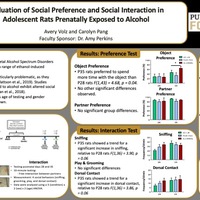Evaluation of Social Preference and Social Interaction in Adolescent Rats Prenatally Exposed to Alcohol
Item
Poster Number
9
Poster Title
Evaluation of Social Preference and Social Interaction in Adolescent Rats Prenatally Exposed to Alcohol
First Presenter
Avery Volz
Other Contributors
Carolyn Pang, Abigail Bartels
Abstract
Fetal Alcohol Spectrum Disorders (FASD), which is caused by prenatal alcohol exposure, can result in deficits in various social behaviors that can influence many day-to-day tasks. Previous studies have shown that subjects prenatally exposed to alcohol exhibit altered social interaction (Diaz et al., 2016; Holman et al., 2018). However, how key variables such as age of testing and gender influence social behavior are unknown. This study evaluated social behavior at early- and mid-adolescence in male and female rats prenatally exposed to alcohol. Pregnant rats were assigned to one of three experimental groups: ad-lib control, pair-fed control, and alcohol-exposed. Ethanol-exposed rats were fed a liquid diet containing ethanol. Pair-fed rats were fed a similar liquid diet to serve as a control group. Ad-lib control rats were given standard rat chow throughout gestation. Behavioral testing occurred on postnatal days 28 and 35, which correspond to early- and mid-adolescence, respectively. To evaluate social preference, rats underwent a 10-minute test that was divided into two five-minute intervals. The first interval, being the “Object Phase” and the second interval being the “Restricted Partner Phase.” During these phases, preference for interacting with a novel object (Object Phase) and a novel social partner (Restricted Partner Phase) were recorded. The next testing stage evaluated social interaction, where the rat and its social partner were allowed to freely interact for ten minutes. The number of specific social behaviors were used to measure social interaction. 35-day old rats showed significantly more social behavior overall, specifically an increase in sniffing and dorsal contact. They also showed a higher preference for interacting with a novel object. No significant effects of sex or treatment group were observed. Taken together, this suggests that mid-adolescent rats are more likely to engage in social interactions with other rats. Future studies might evaluate social interaction in late adolescence.
Year
2022
Embargo
no embargo
